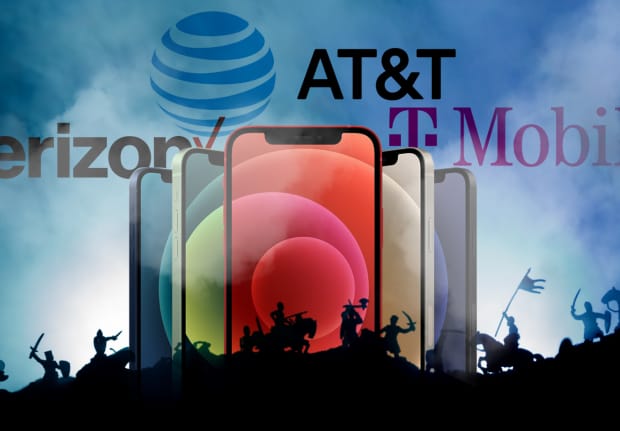This post was originally published on this site

MarketWatch photo illustration/iStockphoto|, Apple
Apple Inc. and consumers are set to win as the wireless industry offers its most aggressive launch-day smartphone subsidies in at least five years, but the steep discounts may wind up hurting the carriers.
Consumers are increasingly holding on to their smartphones longer, but some analysts have been upbeat that Apple AAPL, +0.07%’s newly announced iPhone 12 family, which features 5G connectivity and a wider range of screen sizes, could drive a big wave of upgrades. Wireless carriers, eager to capitalize on the opportunity and avoid getting shown up by their rivals, are heaping on the promotions to both attract new customers and retain existing ones.
Don’t miss: Apple brings 5G to iPhones but keeps the same price tags
The most generous offer so far comes from AT&T Inc. T, -0.93%, which will give both new and existing customers an $800 credit on a new iPhone if they trade in an iPhone 8 or more recent device, in what the company says is a “limited-time” offer for those activating devices on one of its unlimited plans. The credit will be paid over 30 months and AT&T will give smaller credits to those trading in slightly older models than the iPhone 8.
“If someone is willing to pay you $800 for a phone that’s worth $100, that’s a pretty good deal for a consumer and for Apple, but it will obviously impact the balance sheet for the wireless carrier,” LightShed Partners analyst Walter Piecyk told MarketWatch. The $800 subsidy is the largest he’s seen on an iPhone launch day.
Verizon Communications Inc.’s VZ, -1.56% best deal amounts to an $800 subsidy, Piecyk said, but it’s restricted to new subscribers on unlimited plans. T-Mobile US Inc. TMUS, -4.03% is offering half off the iPhone 12 Pro through bill credits, or $500 off any iPhone 12 device, to those who trade in their phones. The company has an offer of $850 off for those who add a line and trade in a phone.
Apple will benefit from carriers’ hefty subsidies to spur phone upgrades, Piecyk said, since about 70% of phone sales in the U.S. occurred from branded stores before the COVID-19 crisis, by his estimation. Carrier promotions tend to be a big driver of phone upgrades.
Wireless deals of this nature typically only occur “late in an iPhone’s life cycle,” wrote Wolfe Research analyst Jeff Kvaal, who agreed that the carrier subsidies could help give iPhone 12 sales an early lift. The deals “may balance an uninspired 5G value proposition that Apple’s examples (mobile gaming, remote MRIs) did little to counter,” he continued.
It remains to be seen whether these promotions could help drive a true “supercycle” for Apple, though, since the U.S. represents less than half of Apple’s total sales. The company’s only true supercycle, in Piecyk’s view, came when Apple expanded its screen-size offerings during its iPhone 6 launch, and that dynamic exists again because there’s a chance that the new iPhone 12 Mini “really appeals to markets that have wanted that” smaller form factor, he said.
For more: Apple makes 5G iPhone seem like a good value, which could be a huge signal boost
The benefits for wireless carriers are far less certain. The heavy promotional approach seems to fly in the face of wisdom from past launch cycles.
T-Mobile ran expensive promotions during the iPhone 7 cycle that kicked off in 2017, and that forced rivals to follow suit. A year later, T-Mobile’s current chief executive and then-chief operating officer Mike Sievert admitted that such an aggressive promotional strategy didn’t pay off since the rest of the industry was doing the same thing. Piecyk flagged Sievert’s comments from a September 2017 Goldman Sachs conference at which he said, “it turns out that free iPhones weren’t a great way to get people to switch.”
The three big U.S. wireless carriers are all in different positions heading into the iPhone cycle and early days of 5G coverage. Now that it can use the spectrum it received through its Sprint acquisition, T-Mobile “has the opportunity to have differentiated network quality, something it didn’t have before,” Piecyk said.
See also: Does 5G make the iPhone 12 worth the upgrade?
That puts pressure on AT&T to keep subscribers and potentially attract new ones. “AT&T has the largest percentage of iPhones in its base and the most to defend,” wrote J.P. Morgan analyst Philip Cusick.
The company is in a tricky spot, however, as it’s especially reliant on its wireless business given problems at its DirecTV unit and elsewhere.
“The challenge is that while [heavy subsidies] could generate good subscriber growth, you still have to generate free-cash flow,” Piecyk said. “The most important thing for AT&T is generating enough free-cash flow to pay the dividend.”
Don’t miss: AT&T’s 7% dividend yield makes stock a ‘value trap,’ analyst says in downgrade
Verizon, meanwhile, seems ready to put a lot of marketing money behind its 5G push, and Piecyk said that it can “lean into” its strong margins while doing so. The company had its chief executive on stage during Apple’s Tuesday iPhone launch event to announce that it was turning on “nationwide” 5G service for 200 million people in addition to expanding access to its faster ultra-wideband 5G service.
Marketing can only get a company so far, according to Piecyk, and the big question is how Verizon’s network speeds will stack up. The number of customers who will be able to access the company’s ultra-wideband speeds will be limited for some time, he argued, and some reports indicated that Verizon’s nationwide 5G doesn’t offer much of a speed boost relative to 4G.

